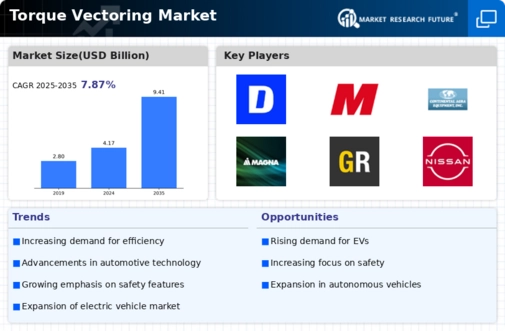Top Industry Leaders in the Torque Vectoring Market
*Disclaimer: List of key companies in no particular order
Exploring the Torque Vectoring Market: A Race for Enhanced Traction
The global torque vectoring market is ablaze with a fervent pursuit of augmented vehicle performance and safety. This dynamic growth has lured in a diverse array of participants, ranging from established automotive titans to agile technology startups, all competing fiercely to claim a leading spot in this exhilarating race.
Key Players and their Strategies:
In this landscape, players such as Oerlikon Graziano (Italy), Continental AG (Germany), ZF (Germany), GKN (UK), JTEKT (Japan), Bosch (Germany), American Axle (US), Schaeffler (Germany), BorgWarner (US), Ricardo (UK), Timken (US), Univance (Germany), Getrag (Canada), Eaton (Ireland), Dana (US), and others hold significant roles. These players have employed various strategies:
● Established OEMs: Automotive giants like Audi, BMW, and Mercedes-Benz have pioneered in-house torque vectoring technologies such as quattro, xDrive, and 4MATIC. Their focus centers on leveraging brand recognition and seamlessly integrating these systems into their premium offerings.
● Tier 1 Suppliers: Bosch, Magna International, and Continental Automotive are pivotal in developing and supplying crucial components like torque-transfer clutches and electronic control units. These entities vie based on technical prowess, scalability, and cost-effectiveness.
● Technology Startups: Disruptive startups like GKN Automotive and Rimac Automobili inject innovation into the market. GKN's eTwinster system caters to torque vectoring for electric vehicles, while Rimac's All-Wheel Torque Vectoring 2 System pushes the boundaries of performance, thriving on agility, niche specialization, and pioneering solutions.
Factors for Market Share Analysis:
Several factors influence market dynamics:
● Vehicle Segment: While high-performance and luxury vehicles currently dominate, the increasing adoption in SUVs and EVs is poised to reshape the landscape, providing an advantage to players catering to specific segments.
● Technology Type: Torque vectoring systems broadly fall under active torque vectoring (ATV) and passive torque vectoring (PTV). Understanding a player's focus on specific technologies and their cost-benefit propositions is crucial.
● Geographical Distribution: The market's variations across regions are significant. North America and Europe lead the market due to their strong premium car markets, while Asia-Pacific is set to exhibit rapid growth, driven by rising disposable incomes and a demand surge for sporty vehicles. Players with targeted expansion strategies or a strong regional presence will hold an edge.
New and Emerging Trends:
The torque vectoring market is experiencing several compelling trends:
● Electrification: The rise of electric vehicles presents an opportunity for torque vectoring to optimize power delivery and handling. Startups like eTwinster cater specifically to this segment, while established players like Bosch adapt their technologies for EVs.
● Connectivity and Automation: Integrating torque vectoring systems with advanced driver-assistance systems (ADAS) and autonomous driving technologies is on the horizon, ensuring future-proofing for players who develop systems in tandem with these trends.
● Lightweighting and Material Innovation: As fuel efficiency becomes paramount, the focus shifts towards lighter and more efficient torque vectoring components. Players utilizing composite materials and innovative designs will gain an edge.
Overall Competitive Scenario:
The torque vectoring market is a dynamic and fiercely competitive arena. To secure a winning position, players need a multi-pronged strategy encompassing continuous innovation, strategic partnerships, regional expansion, and adaptation to new trends like electrification and connected vehicles.
Established OEMs possess the advantage of brand recognition and technical expertise but might face agility challenges due to their size. Tier 1 suppliers offer scalability and cost-effectiveness, but their differentiation could be limited. Startups, with their fresh ideas and nimble structure, have the potential to disrupt the market if they successfully scale up and build trust.
For all players, collaboration and knowledge sharing will be instrumental in accelerating the development and adoption of this transformative technology. As the race for traction intensifies, the torque vectoring market promises to be a thrilling ride for both players and consumers, paving the way for a safer and more exhilarating driving experience.
Industry Developments and Latest Updates:
Oerlikon Graziano (Italy):- Date: October 26, 2023- Source: Oerlikon Graziano press release- Update: Launched the HyCo eDrive, a high-performance electric axle drive system with integrated torque vectoring capabilities designed for EVs.
Continental AG (Germany):- Date: September 12, 2023- Source: Continental website- Update: Collaborating with AVL Diess to develop a new intelligent torque vectoring system for EVs, focusing on energy efficiency and stability.
ZF (Germany):- Date: November 15, 2023- Source: ZF blog post- Update: Showcased its eVDrive2 technology at the Auto Shanghai, featuring an enhanced electric axle with integrated torque vectoring for improved agility and stability.
GKN (UK):- Date: July 6, 2023- Source: GKN Automotive website- Update: Announced a partnership with Magna on the development of next-generation eAxles with torque vectoring capabilities designed for EVs.









